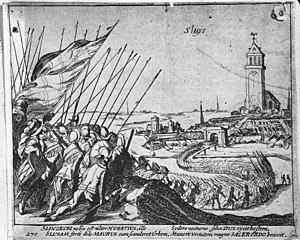
Back Asedio de La Esclusa (1604) Spanish Assedio di Sluis (1603) Italian Beleg van Sluis (1604) Dutch
| Siege of Sluis (1604) | |||||||||
|---|---|---|---|---|---|---|---|---|---|
| Part of the Eighty Years' War and the Anglo–Spanish War | |||||||||
 The capture of Sluis by the Dutch and English army in 1604 from the Atlas Van Loon | |||||||||
| |||||||||
| Belligerents | |||||||||
|
|
| ||||||||
| Commanders and leaders | |||||||||
|
|
| ||||||||
| Strength | |||||||||
| 11,000[1] |
15,000[6] 4,200 (Sluis)[Note A] | ||||||||
| Casualties and losses | |||||||||
| 800 casualties, sick or dead to disease[2] |
2,000 casualties, sick or dead to disease[Note B] 5,800 captured[Note C] 10 galleys[7] 15 assorted ships[8]: 148 1,400 slaves released[6] | ||||||||
The siege of Sluis (1604), also known as the Sluis campaign or the Battle of the Oostburg Line, was a series of military actions that took place during the Eighty Years' War and the Anglo–Spanish War from 19 May to 19 August 1604.[9] A States and English army under Prince Maurice of Orange and Horace Vere respectively crossed the Scheldt estuary and advanced on land taking Cadzand, Aardenburg, and IJzendijke in the Spanish Netherlands.[10] This soon led to the culmination of the siege of the Spanish-held inland port of Sluis.[4][11]
Initially it was hoped that with Ostend under siege for three years by the Spanish, an attempted relief by Maurice's army could be achieved.[12] Even though Ostend would finally fall into the hands of the Spanish, Sluis, an important stronghold itself, was eventually captured after tough fighting which included the defeat of a Spanish relief force under Ambrogio Spinola and Luis de Velasco.[2][5]
- ^ a b Edmondson pp 136–37
- ^ a b c Dalton pp 117–119
- ^ Prak p 66
- ^ a b Dijksterhuis Jan, ed. (1964). C.V. Swets & Zeitlinger. The Principal Works of Simon Stevin, Volume 4 Eduard. p. 25.
- ^ a b Duffy p 89
- ^ a b Motley, John Lothrop (1869). History of the United Netherlands from the death of William the silent to the Synod of Dort, with a full view of the English-Dutch struggle against Spain, and of the origin and destruction of the Spanish armada, Volume 4. pp. 198–200.
- ^ Simoni p 200
- ^ Watson and Thomson, Robert and William (1792). The History of the Reign of Philip III King of Spain, Volume 1. Bavarian State Library. pp. 143–50.
- ^ Jacques p 952
- ^ Markham pp 368–69
- ^ Belleroche pp 69–71
- ^ Knight, Charles Raleigh: Historical records of The Buffs, East Kent Regiment (3rd Foot) formerly designated the Holland Regiment and Prince George of Denmark's Regiment. Vol I London, Gale & Polden, 1905, pp 53–54